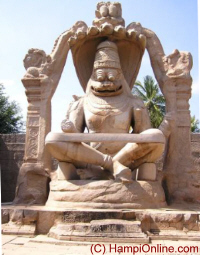
|
This image of Lakshmi-Narasimha,
popularly called Ugranarasimha, meaning Narasimha of terrifying
countenance, is hewn out of a rock in-situ. According to an
inscription found here, it was executed in 1528 A.D. during
the rule of Krishnadevaraya. Originally, the icon bore a smaller
image of Lakshmi sitting on his lap. This gigantic image,
6.7 meters in height, was mutilated and the figure of Lakshmi
was entirely damaged and vandalized in 1565 A.D. Narasimha
with an articulately chiseled and well delineated mane and
large bulging eyes and broad chest still retains His awesome
charm. He is seated on the coils of the snake Adisesha, who
rises behind him with seven hoods, which serve as a canopy.
The entire image is set within a Makara torana, or arch, with
a lion-mask above the hoods of Adisesha.
The statue of Lakshmi can
now be found at Kamalapura Museum.
|
|
As mentioned above, the
whole statue of Narasimha and Lakshmi was cut in a single
boulder. While other kingdoms further southwards used Schist,
a soft stone as the medium of their constructions, the Sangamas
decided to go in for granite as the building material for
their temples. The hard granite was available on the site
in plenty and was economic. Granite, being hard, was not suitable
for the delicate filigree work that could be carved on Schist.
What the artists had to sacrifice on the delicacy of the work
was compensated by the massiveness of the sculptures. The
statue of Ugra Narasimha is a perfect example of what they
achieved in volume which they could not in delicacy.
|
 |
